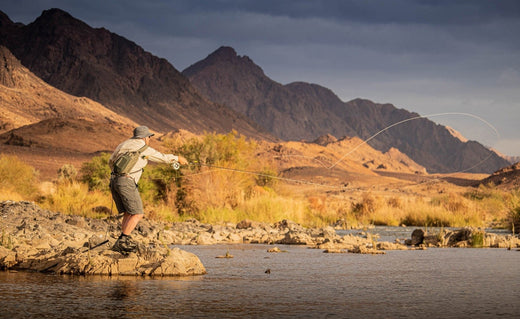Take your mind out the gutter!
This is not that kind of “how-to” guide….
Although swinging flies is regarded by most, as a technique reserved for targeting anadromous fish while wielding large 14ft double-handed Spey rods in the northern hemisphere. It is a technique that has been adapted and tweaked the world-over for a plethora of other predatory fish. Take the African continent for example: Tigers on the Zambezi; Giant Trevally in estuary mouths and what we will focus on in this article specifically – Yellowfish on the Orange River.
In fact the method – which involves utilising the current to get your fly to the feed zone – has accounted for the majority of Largemouth and big Smallmouth landed over the years of trips we’ve done.
Here’s a bit more of what you need to know about the The Swinger’s approach:
-
OBSERVATION
Like any fishing method, observation of environment is always the first step and the one many people overlook. A cautious and stealthy approach whether on foot or by boat goes without saying. Largemouth are very habitual in the sense they stick to a behaviour pattern and stay in an area for the most part. Enough so that you do not need to rush things. Sitting and looking for any tell-tail signs, understanding the nuances and characters of the area and most importantly identifying all the primary lies (more on this later) is crucial to maximising each cast as each time you put fly line on water, your chances will diminish as your presence becomes known. Especially when fishing a gin clear sight-fishery like the Lower Orange River. -
FISHING THE A TO Z
We rely on a simple, but methodical approach. Whether fishing a uniformed tail or a structure loaded boulder garden. Always start with a short cast, progressively casting further with each subsequent cast. You want to avoid ‘lining’ fish by casting over them. With swinging you must ensure you show the fish the fly not the belly of line. It’s a very common mistake when arriving at a piece of water and straight away bombing out the longest cast to the furthest spot often lining fish and spooking them. -
ALL ABOUT THE MEND
This is a very important part of the swing and often were things go wrong. The mend does many things for the swing. It allows you to adjust the depth you are fishing, the degree/angle you want the belly to form, allows you to avoid conflicting seams and currents, it also allows you to fish different area below you depending on side/angle you mend without having to adjust the anchor or your position. -
VARY YOUR RETRIEVE
Experiment with different retrieves until you get to the one that works. Obviously during the swing you should never actually retrieve your fly, you can however impart some movement and create an action if the standard swing is not producing. This can be done with a short draw-and-release at varying speeds and frequency. -
THE DANGLE
This remains one of the most effective parts of the swing for us when targeting Largies. Our theory is that the fish will often follow the swung fly which is moving predictably through the water. When the fly then finishes swinging, it hangs in a position known as ‘the dangle.’ This change in movement (or lack thereof) induces the eat. What we will often do is ensure the dangle happens in half decent water for a start. Fish the swing right through to the end, allow the current to then push the fly into the dangle position whereby it will often result in the fly flaring in the current with more than enough action. We then manipulate it further by doing a series of downward rod taps drawing and feeding the fly in and out of the area. Often resulting in some incredible takes and explosive runs.
Once finished move the fly out of the ‘zone’ and quickly retrieve the fly back to cast again. Fishing the fly directly back up-current after the swing is a very unnatural movement and not worth investing the time in fishing.
THE DO’S & DON’TS OF SWINGING
- Always check hook points, dumbbells and for abrasions on your leader. Often while fishing in between rocks you will be bumping flies, check for any damage and replace straight away.
- Considering the belly in the line, most takes will register very subtly because of the indirectness of the swing. Sometimes you can simply feel the change in resistance. Strike first, ask questions later!
- Avoid tapered leaders. A straight tippet (we prefer fluoro to mono for this application) will assist in your fly getting down as quickly as possible and staying there.
- Be ready from the word go. Often anglers will cast, start swinging through good water and then decide to remove more line for the next cast resulting in a loss of attention to your current cast and missed opportunities. Get all your line ready before fishing, do the necessary preparations and make sure when the fly hits the water you are focused and ready.
- Make sure you get your mend in straight away. The longer the line is on the water the more drag sets in resulting in the line being ‘ripped’ off the water which is a big no.
- The less mends the better – avoid over-mending. This happens a lot when people readjust during the swing creating multiple bellies in the line and no contact at all between rod and fly.

